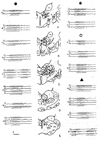FIG. 1
Recruiting responses (records A–H, at left) and spike-wave complexes (records I–Q, at right) evoked by low frequency stimulation of thalamic sites indicated by appropriate symbols on transverse sections through diencephalon (levels A–E, center). Channels record activity from anterior (A) middle (M) and posterior (P) regions of cortex, homolateral (H) or contralateral (C) to side of stimulation, and occasionally from caudate nucleus (NC). Responses were elicited from Stimulating anterior reticular nucleus (records A, B), antero-medial (C), ventralis anterior (D, E, I, J, L), centralis medialis (records F, G), centre median (H), the ventralis medialis (M), ventralis lateralis (O), medial geniculate (P), lateralis posterior (Q) and internal capsule (K, N). Anesthesias employed were: nembutal(records A, L, G, I, M, N, P, Q), chlorolosane (B, D, J, K), beta-erythroidine (F, O) and encephalé isolé (E, H, L). Stimulus voltages varied between 2 and 7, and were usually 5. Legends on diencephalon are: A—anterior nuclei, BP—basis pedunculi, C—centralis medialis, CA—caudate, CL—centralis lateralis, CLA—Claustrum, CM—Centre median, F—fornix, GP—globus pallidus, H—habenula, HP—habenulo-peduncular tract, HV—hypothalamic ventromedial nucleus, IV—internal capsule, L—lateralis posterior, LA—lateralis anterior, LG—lateral geniculate, M—medial nucleus, MB—mammillary body, MG—medial geniculate, OT—optic tract, P—pulvinar, PU—putamen, R—reticular nucleus, SU—subthalamus, VA—ventralis anterior, VL—ventralis lateralis, VM—ventralis medialis, VP—ventralis posterior. Dots indicate diencephalic sites whose stimulations did not evoke wave responses in cortex. Vertical calibration—l00 µV; horizontal calibration—1 sec.








